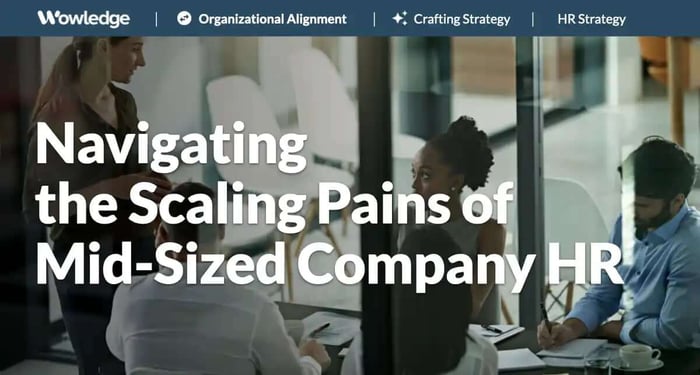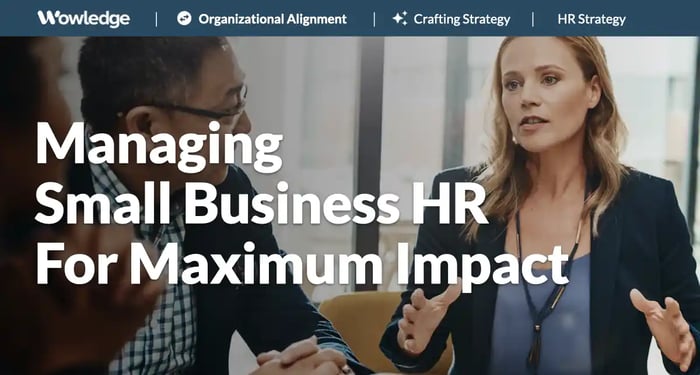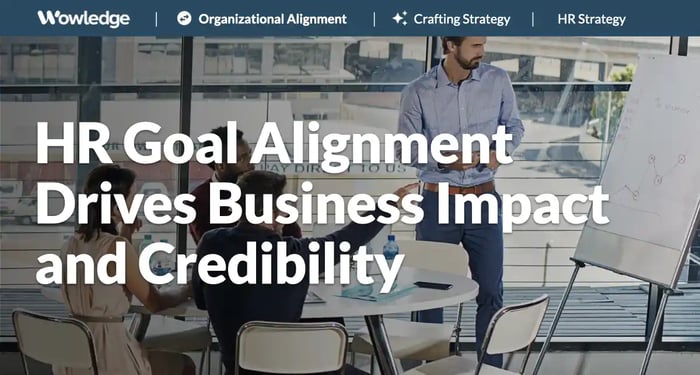Table of Contents
Leading an HR function comes with its challenges, but those can vary considerably across organizations of varying sizes. While small business HR teams face issues related to their operating model and the range of services they provide, large business HR teams focus on challenges such as technology-enabled service delivery, building culture and engagement, and continuously growing a pool of future leaders ready to address the threats and opportunities facing their employer. Similarly, mid-sized company HR teams have a unique blend of challenges that require business-aligned and tailored approaches designed and executed by an often lean group of HR professionals.
The nature of mid-sized companies
Out of an estimated six million+ employers in the United States, 5%, or 300,000, are considered “midsize” businesses. According to J.P. Morgan Chase, these middle-market organizations generate $13 trillion in annual revenue and employ over 40 million people, representing one-third of U.S. revenue and accounting for 30% of the American workforce. Estimates of the relative size and revenue base of these middle-market organizations vary, but can be summarized as those employing between 500-5,000 employees, with annual revenues between $10 million and $1 billion.
While mid-sized companies exist in every industry and sector in the U.S., they employ workers most prominently in:
- Retail (16%)
- Construction (14%)
- Healthcare (10%)
- Professional Services (11%)
- Wholesale (10%)
- Manufacturing (7%)
Business issues commonly facing mid-sized organizations
Organizations in the middle market are commonly challenged by matters related to scaling up and expanding their business, managing their growth aspirations against often limited budgets and staffing, and implementing process and technology upgrades that generate the needed operational efficiencies. Mid-sized company HR leaders and their teams should be well-acquainted with those, including:
- Less mature planning capabilities. Mid-sized companies often struggle with implementing more advanced strategic plans, market studies, and financial analysis required to target opportunities for enhanced growth and stability. These naturally require advanced skills, tools, and technologies to create plans and collect, model, and interpret data.
- Growth needs to be funded. Securing the financing necessary to fund capital investments in facilities, equipment, personnel, and technology has become increasingly challenging, yet it remains core to achieving larger-scale growth ambitions. Consider that, according to JPMorgan Chase, the annual growth of commercial and industrial loans has flattened out over the past five years to -2%, while 42% of banks report tighter credit standards. The better news is that, while growth is slow, private credit lending has grown by 12.2% since 2012, with 70% of this investment directed towards established (as opposed to early-stage and emerging) middle-market companies. Similarly, private equity (PE) has gradually become a player in the middle market, with investments growing by five times (5X) over the previous 15 years.
- Cash flow management. Where credit card debt and loans from family and friends can suffice in supporting shorter-term investments in small businesses, managing expenses in mid-sized organizations with higher costs can be difficult. Consider the higher level of operating expenses that have to be funded from existing cash flows. The volumes of raw materials, components from suppliers, and marketing buys are combined with higher costs related to debt service, lease and rent, payroll, and employee benefits. One in three mid-sized organizations reports that the availability of sufficient investment capital is insufficient for their current needs.
- Meeting customer priorities. Competing with larger and more sophisticated companies requires an outstanding customer experience, which incorporates quality products and services, reliable delivery, and efficient and “friction-free” sales and service processes. These customer expectations, when consistently met or exceeded, often serve as critical differentiators against larger enterprises. The challenge for mid-market companies is managing process upgrades that can keep pace with increasing volumes while maintaining product and service quality, and making spending as efficient as possible.
- Technology adoption and upgrades can stretch budgets. The availability of modern and advanced technologies that can support rapid growth and expansion aspirations comes with costs, risks, and readiness (infrastructure and staffing) challenges. Mid-sized companies often find themselves in the middle between small market platforms and solutions, and the more sophisticated and elegant solutions offered to large-market organizations. Addressing the affordability gap only scratches the surface, as advanced manufacturing, warehousing, distribution, financial, procurement, supply chain, and HR solutions require IT expertise to support well-informed purchasing, configuration, integration, storage, reporting, and cybersecurity requirements. Further proficiencies in strategic change management, training, tools, and methods, as well as user acceptance and adoption, are essential but challenging for many mid-market organizations.

Talent challenges in middle-market businesses
Mid-sized company HR teams tend to be leaner and often lack the breadth and depth of knowledge and expertise needed to support every HR and talent challenge that arises. The range of issues that require responses can be extensive, with many familiar to employers of this size and scale, and thus predictable in a way that enables HR leaders to be aware of their risks and therefore prepared at even a basic level.
Leadership quality
Many mid-sized organizations have leaders who are adept at identifying short-term or mid-term growth opportunities and handling the goals and issues associated with their current scope and scale of operations. However, growth requires leadership with vision, market expertise, and experience, as well as scaling knowledge, the ability to distinguish between what is needed and what is wanted at any stage of development, and the capacity to navigate fluctuations in fortunes. As the company’s markets and workforce change or expand (in size, geographic locations), complexities increase, often creating confusion and misalignment about its mission as it evolves. Leadership development and succession planning (especially for owners and founders) have become critical capabilities that mid-sized HR leaders should press to support the needed evolution of leadership pools that will prepare them for more complex and advanced challenges.
Competition for top talent
Mid-market employers face the same talent shortages common to all organizations, but with the added burden of getting and sustaining the attention of needed workers against intense competition from leading and better-resourced competitors. Larger employers can offer higher salaries, more comprehensive benefits, and greater prestige, while smaller employers can offer more flexibility, quicker advancement, and opportunities to make significant contributions. The need for effective branding and candidate interactions, their fast and effective processing, and structured assessments that increase the likelihood of a quality employee-employer match cannot be overstated as a competitive advantage.
Culture drift
As companies grow and expand their employee base, geographic operations, or product and service lines, these changes, along with associated shifts in leadership, company mission, and direction, can inadvertently alter the culture. Mid-sized company HR teams should be aware that any influx of new talent can impact an organization’s preferred cultural profile – its core values, beliefs, and operating style. The expansion to new locations, whether in other parts of the country or abroad, can introduce new and different employee expectations, work ethics, communication styles, and collaboration approaches. The entry into new markets, industry segments, or product or service offerings can expose existing leaders and employees to new customer, partner, and government regulator expectations, requirements, and standards. These can create unplanned shifting or splintering in a company culture that requires attention to maintain alignment across every level of leadership, management, and employee.
Scaling operations
As a mid-sized company expands in response to market opportunities and projections, challenges arise related to organizational design, resource allocation, expense levels, and staffing requirements. Mid-sized company HR teams are often required to consult and inform planning efforts in conjunction with line management, finance, real estate, and technology (IT) functions. Balancing minimum staffing levels and costs, assessing competitive pay and benefits, understanding local recruiting markets versus employee mobility opportunities, and skill development requirements can represent efforts that overwhelm existing team capabilities and resources.
Regulatory and legal challenges
As organizations grow, employ more people, and become more prominent in communities, geographic regions, or industries, a heightened risk of employment-related challenges accompanies them. Larger organizations employ not only more workers but also more managers, whose actions, decisions, and behaviors can, or be perceived to, violate national, state, or local laws and regulations. Disgruntled or unfairly treated workers can bring charges that must be investigated, responded to, filed, defended, and, if lost, paid out in back pay, settlements, and fines. Mid-sized company HR professionals must understand existing or new country, regional, or state laws and regulations, including those associated with requirements for newly entering industries, which is an essential requirement that can challenge mid-sized company HR teams.

Priorities and solutions for mid-sized company HR teams
Mid-sized company HR teams must work within tight budgetary limitations, prioritize their investments in time, effort, and expense wisely, and continually seek greater process and cost efficiencies in their offerings. At the same time, they should focus on the future, helping the organization move into the next stage of growth and preparing its people to build and manage a larger, more dynamic company. That requires planning and executing against a vision while building a culture and people infrastructure that is ready to support the organization's current and future needs. Key opportunities and priorities for mid-sized HR teams should include:
1. Developing impactful HR and talent strategies
Many mid-sized company HR functions operate without a documented strategy, instead relying on the performance goals and objectives of the CHRO, HRBPs, and functional teams (e.g., COE experts or teams), and cascading them downward to their subordinates or teams. The most critical starting point for upgrading any HR function is to articulate strategies, tactics, and plans that flow directly from those of the business. The advantages of working in a small to mid-sized organization are the proximity and access to leadership, as well as the ability to understand their operations, work processes, challenges, opportunities, and people. HR leaders should leverage these opportunities to develop plans that prioritize investments and budget requirements, allocate lean HR resources effectively, and foster confidence in HR's focus and contributions.
Create and manage an HR strategy, and then an aligned talent strategy that defines how the organization’s staffing needs will be cost-effectively met through a combination of hiring, training, outsourcing, automation, retention, and performance management, thereby managing both staffing costs and skills requirements simultaneously.
2. Managing the company culture
Culture defines and molds how employees operate daily, and drives much of the employee experience that determines their level of engagement, sense of belonging, and their willingness to go the extra mile to meet company business and customer objectives. And as they say, “culture trumps strategy." Sadly, Gallup has found that only 20% of employees strongly agree that their managers and colleagues explain how and are committed to the organizational values.
To create and sustain a work environment that differentiates the company from the competition and drives improved business outcomes, mid-sized company HR teams should generate clarity about the company’s mission, vision, and values. Integrate those into communications, policies, practices, and standards for hiring, performance management, leadership and managerial selection, compensation, and promotions. In a mid-sized company, such differentiation and employee alignment can be achieved at a level that measurably impacts attraction, engagement, and the quality of management.
As new operations and locations are opened, take a cue from leading organizations and engage “culture carriers” to stand up, lead, onboard, and integrate new leaders, managers, and employees. Leverage role models who demonstrate and act according to the company values to establish those as standards by which all newly hired, transferred, or contracted workers are guided, managed, and held accountable.
3. Attracting thoughtfully and hiring carefully
While resources may be limited and mid-sized company HR staffing lean, the need to hire talent most effectively and efficiently is an essential element in mid-sized organizations with smaller work teams. Candidate assessment should not be rushed, as the cost of a skills, aspirations, or cultural mismatch leads to new hire turnover, suboptimal performance and contributions, and lost team productivity.
Develop an employee value proposition (EVP) that emphasizes the benefits and virtues of working and developing a career in the organization. Many mid-sized companies can offer smaller work team sizes, greater visibility with leadership, proximity (and the opportunity to influence) decision-making, and faster advancement. Focus on positive cultural values and markers, such as a sense of belonging and camaraderie, the meaningfulness of work, ownership, and personal alignment with the company’s mission.
Hire using culturally-driven values, using various methods to assess candidate integrity, respect, customer focus, initiative, collaboration, resourcefulness, and creativity. Select soft skills that promote better teamwork, innovation, and attention to the needs and requirements of the customers of the business’s products and services. Look for candidates who possess multiplexed skills, having broad experience in applying them, which can be utilized in various roles and circumstances. Candidate flexibility and agility are beneficial in small to mid-sized organizations.
4. Designing jobs that attract, motivate, and retain
Develop structured approaches to working with line managers as they define jobs to be filled, incorporating elements that have been proven to engage and motivate high performance and business contributions. Reimagine workflows and job designs that enable job autonomy, meaning, flexibility, and creativity, allowing individuals to leverage their capabilities fully while developing themselves and their peers. Mid-sized company HR teams should strive to strike a balance between fostering a sense of ownership and engagement in employee work efforts, while driving continuous improvement in business operations. Create compensation practices that encourage both employees and their managers to focus equally on improving work process efficiencies and product quality.
5. Managing performance constructively and developmentally
A key difference between small to medium-sized businesses is the flexibility and adaptability that their size and scale allow relative to larger competitors. Design performance management as a continuous (versus annual) and flexible process. Encourage managers to provide regular feedback and coaching sessions with each employee, allocate time for these sessions, and hold them accountable for the quality and developmental focus of these sessions. Focus employees on only a few business-critical goals, cascaded downward and aligned with those of their top leaders. Provide development goals that align with their aspirations and career objectives, and offer regular guidance on how to achieve growth and advancement. Measure and manage performance based not only on what is accomplished (e.g., tasks and goals), but also on how it was achieved (e.g., demonstrated competencies), and the extent to which it aligns with company values (e.g., exhibited ideals) while performing the work.
6. Developing intelligently, continuously, and cost-effectively
Greater cost and budget pressures present opportunities for more practical, effective, and cost-efficient learning and development strategies, such as experiential learning. Embed skill and capability development into the context of an individual’s work, by increasing on-the-job development, such as special project team assignments, stretch tasks and responsibility assignments, job rotations, internal apprenticeships, or short-term cross-functional duties or deployments. Create group learning events to create cross-functional bonding, collaboration, and idea (and work method) sharing. Support a customer focus by offering more employees opportunities in customer-focused or customer-facing roles, assignments, and projects. And finally, leverage learning technologies and experts (e.g., L&D professionals) to guide employees towards more targeted and personalized learning paths aligned with the strategic direction of their functional roles, career fields, and professional aspirations.
7. Focusing on retaining critical skills and role employees
The smaller the team(s), the greater the pain of turnover. But being able to track and create a special focus on every employee is not realistic. What is realistic is paying closer attention to those who produce a disproportionate impact on the achievement of the company's mission, its strategic goals, and its customer experience. Critical workforce segmentation (CWS) categorizes every job according to its relative strategic value and importance, serving as a prioritization scheme for targeting those employees whose loss would be most significant. Create targeted policies, programs, and pay and benefit plans that address their specific needs and preferences.
Make employee listening more than an annual or occasional survey—activate and engage employees in designing solutions to their most significant pain points or gripes. Take action on employee feedback by communicating plans to address concerns, chartering project teams to solve workflow and administrative process problems, and making the employee experience (EX) smoother and easier. Promote and celebrate their accomplishments to send messages to the workforce that the company cares and is willing to adapt and improve the work environment for their benefit.
8. Updating management roles and assessment techniques
The issues that companies of every size and industry are experiencing with middle management roles are daunting, marked by record-low manager engagement scores, high burnout rates, widespread complaints about overwork, and challenges in adapting to changing employee expectations. Job redesign presents a critical opportunity, necessitating clear-eyed reviews of the balance between oversight and management of workflows, personnel, and budgets, as well as technical contributions, project management, and reporting requirements. With the significant impact that managerial behavior and decisions have on employee engagement and overall satisfaction, a structured and formal approach to delegating and offloading specific job tasks can provide them with the time and space to focus on managing people effectively.
Managerial selection and promotion decisions should be based on a broader set of more objective criteria that provide a more accurate assessment of the extent to which candidates for these roles possess and consistently act as constructive, effective leaders of others. A focused effort should be taken to define and validate the competencies, behaviors, and actions that separate the best people managers in the company’s roles. Skills and aptitudes such as active listening, conflict management, emotional intelligence, coaching, and feedback should be included in a review of required skills.
Performance management of people leaders should take all of those capabilities and job requirements into account, with upward or 360-degree surveys used to augment senior leaders’ direct observations. Assess the extent to which each manager role models (demonstrated and observed) company values, conducts individual and group sessions to communicate direction, coach and develop, and provide meaning (“your efforts in [A] are contributing directly to the company’s [X] goal”). Their goals and KPIs or OKRs should be continually aligned and adapted to changing business priorities and objectives.
9. Incorporating values-driven programming
The larger portion of the workforce (Millennials, Gen Z) is much more attuned to and focused on their organization’s social and community contributions. Create company-sponsored opportunities for community involvement, charitable contributions, and social welfare to both engage workers and demonstrate a corporate commitment to the values they embrace. Consider rewards and recognition programs that include making contributions to a defined set of worthwhile organizations and matching employee contributions.
Create strategic partnerships that provide volunteer opportunities while training and attracting future workers in targeted skill areas such as high school STEM mentoring, technology boot camps, or community college or trade school project competition sponsorships. Sponsor (paid) company-wide service days with projects suggested by employees to improve public spaces and community organizations. Encourage employees to take initiative and develop their skills through suggestions, project design, budgeting, and leadership opportunities.
Relevant Practices & Tools
Emerging Recruiting Strategy and Sourcing Practices to Streamline Talent Discovery. >
Exponential technologies such as Artificial Intelligence (AI) continue to evolve in their application across functions and industries to solve complex problems and automate a broader range of activities... more »
Defining Diverse Types of Awards to Support the Organization’s Culture and Enhance Overall Employee Engagement. >
Recognition is an institutionalized way of saying “thank you” to employees for a job well done and for the extra effort they put into their work... more »
Developing Competency Models that Guide Feedback and Development Goals. >
Job competencies are the capabilities required to successfully apply knowledge, skills, and abilities on the job, commonly thought of as “success factors”... more »
Incorporating Coaching and Mentoring into Performance Management to Better Engage Employees in their Own Performance. >
Enhancing managerial feedback and coaching is a process informed and driven in part by training and development, in part through feedback, and in part by reinforcement or rewards tied to excellence as a coach... more »
The HR Business Challenge Goal Conversion Tool: Translate Identified Challenges into Clear and Distinct HR Goals. >
This tool is used in a sequence of analyses that convert key business objectives, external, and internal environmental scans into HR challenges that can subsequently be converted into HR goals and objectives... more »
About Wowledge
Wowledge is the implementation-first platform designed for lean HR teams and consultants who need to design and scale strategic HR programs efficiently—without starting from scratch.
Our members gain access to continuously updated best practices, step-by-step guidance, expert-built tools, and customizable templates—all structured to accelerate the development and implementation of key HR programs.
Recognizing that every organization operates at different levels of sophistication, Wowledge’s scalable system of best practices follows a stage-based approach—Core, Advanced, and Emerging—ensuring HR professionals can implement solutions tailored to their organization’s unique needs and goals.
Your Shortcut to Amplifying HR Impact!
Get started for FREE! Learn more.










